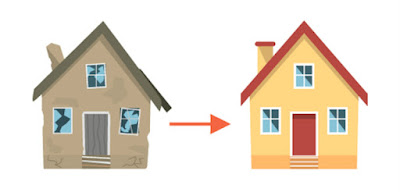When properties are “flipped” for a quick profit, the sellers usually make out OK. But what about the buyers? How can they be sure you’re not buying a flop?
Buying a flipped house has a lot of appeal: They’re usually attractive, move-in
ready homes with updated fixtures, appliances, and finishes. However, the
quality of renovations done during the flipping process is a big factor for a
potential buyer to consider. While some home flippers do top-notch jobs and pay
attention to every detail while updating a property, others do it in a rush to
make a quick buck — sometimes with subpar work.
While an inspector should point out the major flaws in a home before you buy
it, such as roof or foundation issues, there are smaller red flags you can look
for while touring a property that indicate it may have been flipped in a hurry.
Some surefire signs of a too-quick flip include loose railings that have been
poorly reinforced, painted-over water damage under sinks or on ceilings,
painted-over dust in air vents, smoke detectors that weren’t replaced, or
leftover renovation debris remaining in the home.
Here are a few other things to watch out for.
Flaws in the new flooring
If you want an immediate assessment of the overall quality of a flip, just look
down — at the flooring. Poor workmanship on new flooring is a warning sign. You
might spot a cracked tile and figure that’s an easy fix. However, it could
indicate a much bigger problem: the flipper might not have laid the subfloor
correctly. If it just doesn’t look right, particularly at the trim, that’s
going to be the most obvious to a potential buyer. If there is flooring butted
up to base molding and butted up to door jambs, that’s a big red flag. The
proper method is to remove the base molding and cut out the bottoms of the door
jambs and lay the flooring beneath them.
Crooked cabinets
In the kitchen, don’t just look at the amount of cabinet space or the quality
of the hardware. Check to see if the cabinets are properly aligned vertically
and horizontally. If not, that’s a sure sign they weren’t level and even all
around.
Ceiling spots
Always look at the ceilings for signs of water damage, If there’s been a leak,
you can usually tell by spots, patches, or discolored paint. Be sure to check
around light fixtures, where water is likely to pool. If you see signs of water
damage, ask the seller what happened, because it could indicate a problem with
the roof that might not have been properly addressed — leading to costly
expenses down the road. Go to the attic, and look up at the inside of the roof,
if you can. Roofs are expensive to replace, and if there’s a leak, you’ll see
it there.
Shoddy painting
If the flipper spent the time and money on a proper paint job, you shouldn’t
notice things like uneven edges, errant drips of paint on fixtures or the
floor, or electrical outlets and light switches that have been painted over
instead of removed first. These items are really cheap to buy and easy to change
out, so I don’t know why some people do this. Also look closely at the
baseboards and check to see if they were cleaned before being painted.
These are just a few items to look for on your own. The best practice is to
hire an experienced home inspector. Perhaps one who specializes in inspecting
recently renovated “flipped” homes. <


No comments:
Post a Comment